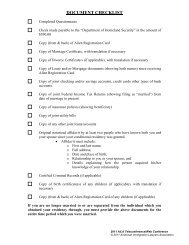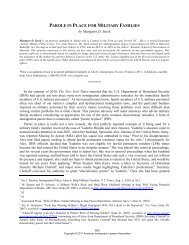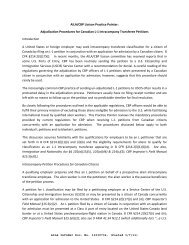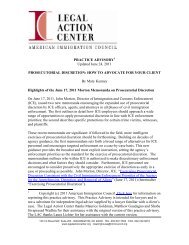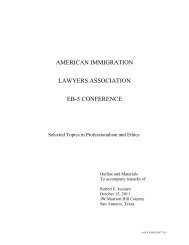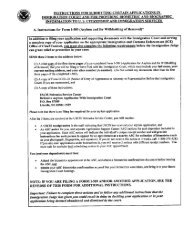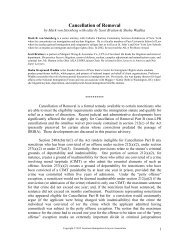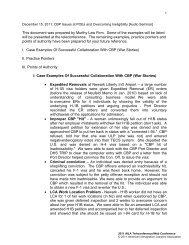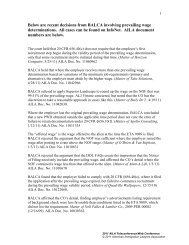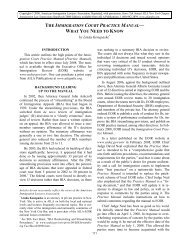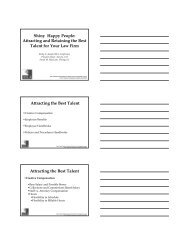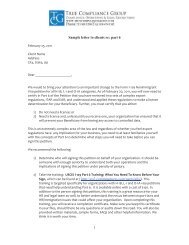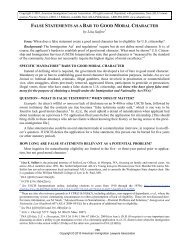Ch 5-Motions before the Immigration Court - AILA webCLE
Ch 5-Motions before the Immigration Court - AILA webCLE
Ch 5-Motions before the Immigration Court - AILA webCLE
You also want an ePaper? Increase the reach of your titles
YUMPU automatically turns print PDFs into web optimized ePapers that Google loves.
130 IMMIGRATION JUDGE BENCHBOOK<br />
that <strong>the</strong> seizure of <strong>the</strong> alien violated <strong>the</strong> Fourth Amendment but statements obtained from <strong>the</strong> alien as a result<br />
of <strong>the</strong> illegal arrest were admissible at <strong>the</strong> deportation hearing).<br />
14. Trained and experienced immigration officers may draw inferences and make deductions based on an assessment<br />
of <strong>the</strong> whole picture, which can supply a basis for a valid investigatory stop predicated on a reasonable<br />
suspicion of illegal activity. United States v. Cortez, 449 U.S. 411 (1981).<br />
a. An investigatory stop cannot support prolonged interrogation without probable cause to believe that a violation<br />
has occurred, particularly if <strong>the</strong> detained person is required to accompany <strong>the</strong> officers to <strong>the</strong>ir office.<br />
Dunaway v. New York, 442 U.S. 200 (1979).<br />
b. The <strong>Court</strong> in United States v. Martinez-Fuerte, 428 U.S. 543 (1976), upheld <strong>the</strong> power of immigration officers<br />
to stop automobiles and question <strong>the</strong>ir occupants concerning <strong>the</strong>ir immigration status at reasonably located<br />
traffic checkpoints even in <strong>the</strong> absence of individualized suspicion of any impropriety. It is also constitutional<br />
to refer motorists selectively to a secondary inspection area for fur<strong>the</strong>r inquiry on <strong>the</strong> basis of criteria<br />
that would not sustain a roving-patrol stop even if it be assumed that such referrals are made largely on <strong>the</strong><br />
basis of apparent Mexican ancestry. Factors that may be taken into account in determining whe<strong>the</strong>r stopping a<br />
vehicle in a border area is justified: characteristics of <strong>the</strong> area; proximity to <strong>the</strong> border; patterns of traffic on<br />
<strong>the</strong> particular road; previous illegal traffic; information about recent illegal border crossings in <strong>the</strong> area; behavior<br />
of <strong>the</strong> driver (such as erratic driving or obvious attempts to evade officers); appearance of <strong>the</strong> vehicle<br />
(load, compartments, large number of passengers); occupants trying to hide. The government argued that<br />
trained officers can recognize <strong>the</strong> characteristic appearance of persons who live in Mexico, relying on such<br />
factors as <strong>the</strong> mode of dress and haircut. The <strong>Court</strong> however found that Mexican ancestry would not in itself<br />
support a reasonable suspicion that <strong>the</strong> occupants in <strong>the</strong> vehicle were aliens, but that it could be taken into<br />
account as a relevant factor. In all situations <strong>the</strong> officer is entitled to assess <strong>the</strong> facts in light of his or her experience<br />
detecting illegal entry and smuggling.<br />
c. A brief “investigatory stop” of a suspicious individual in order to determine his or her identity or to maintain<br />
<strong>the</strong> status quo momentarily while obtaining more information may be reasonable. Adams v. Williams,<br />
407 U.S. 143 (1972).<br />
15. Under appropriate circumstances, a proper interrogation may involve some measure of restraint, short of<br />
arrest, to complete <strong>the</strong> interrogation. Matter of Yau, 14 I&N Dec. 630 (BIA 1974); Matter of Wong and <strong>Ch</strong>an,<br />
13 I&N Dec. 141 (BIA 1969).<br />
Forcible temporary restraint incidental to interrogation is valid, and any resulting evidence is admissible, if<br />
<strong>the</strong> officer acted reasonably, in <strong>the</strong> light of <strong>the</strong> surrounding circumstances. Lau v. INS, 445 F.2d 217 (D.C.<br />
Cir. 1971), cert. denied, 404 U.S. 864 (1971).<br />
16. A search conducted with <strong>the</strong> consent of a person who is not in custody is valid if <strong>the</strong> consent is voluntarily<br />
given, without any duress or coercion, express or implied. Schneckloth v. Bustamonte, 412 U.S. 218 (1973).<br />
The government has <strong>the</strong> burden of showing that such consent was voluntary, based on <strong>the</strong> totality of all <strong>the</strong><br />
surrounding circumstances.<br />
C. MOTION TO REDETERMINE BOND OR CUSTODY DETERMINATION<br />
Pursuant to 8 C.F.R. §1003.19(e), after an initial bond redetermination, a request for a subsequent bond redetermination<br />
shall be made in writing and shall be considered only upon a showing that <strong>the</strong> alien’s circumstances<br />
have changed materially since <strong>the</strong> prior bond redetermination. See Bond/Custody for more information.<br />
Also, for procedures in automatic stay cases where DHS intends to invoke an automatic stay of an IJ’s decision<br />
ordering an alien’s release in any case in which a DHS official has ordered that <strong>the</strong> alien be held without<br />
bond or has set a bond of $10,000 or more, see Interim Operating Policies and Procedures Memorandum 06-<br />
03, Procedures for Automatic Stay Cases, dated October 31, 2006.



